$750K photography initiative leverages Cornell resources
By Daniel Aloi

Cornell University Library and the Herbert F. Johnson Museum of Art are collaborating on a four-year initiative engaging Cornell photography collections and sharing staff and resources in new ways.
The project, “Crossing the Photographic Divide: Mining and Making Meaning,” will receive $500,000 in funding from The Andrew W. Mellon Foundation through academic year 2020-21. The Mellon grant will be matched by $250,000 in funding raised by the museum.
Cornell submitted a proposal to a Mellon competition last summer seeking innovative projects emphasizing sharing staff between museums and libraries. The project aims to use the “vast, interconnected and unique photographic collections” held by the library and the museum to “create new dialogues in and outside of the classroom, broaden areas of inquiry in teaching and research, and present joint programs that communicate how the impact of collections are strengthened and expanded through partnerships,” the proposal states. “Visual information … offers fertile territory for the creation of interdisciplinary knowledge and for the consideration of specific questions related to curating, discovery, use, and interpretation.”
The collaborative effort’s title refers to what “has been an artificial divide between museum and library collections, and probably nowhere is that more obvious than in photography,” Carl A. Kroch University Librarian Anne Kenney said. “Typically, libraries don’t collect art, they collect documentation. Where does one start being one and stop being the other?” She added that a collection of Liberty Hyde Bailey’s cyanotypes of apples and plants and flowers “is one of the more stunning things that the library has.”
The library has over a million photographs among its holdings, while the museum has about 9,000 fine art photographs, said Stephanie Wiles, the Richard J. Schwartz Director of the museum.
“The core of the project is trying to find new ways to understand campus collections and use them more broadly,” Wiles said. “It’s a great way to push the museum’s photography initiative forward – over the past year we’ve had a photography task force, and the library was completely on board because of its holdings.”
Project support will include a consultant with deep knowledge of Cornell collections, former New York Times critic Andy Grundberg ’69; as well as a new curator of photography and a cataloger, each shared by both units.

Photography is among the most popular, relevant and in-demand content for teaching, exhibitions and programs at Cornell. Approximately 50 percent of all class visits to the museum incorporate photography. The new curator will support “the identification of content across the two collections, helping to build awareness of it and working with faculty,” Kenney said, while the cataloger will log metadata on images “and be building a way to cross-search across these huge databases,” she said.
Working groups of faculty, librarians and curators will develop new courses around photography collections, and related programming including symposia with world-class artists and experts.
Five thematic teaching sets of images are identified in the proposal – one representing an introduction to photography; a set supporting Asian studies; one focused on landscape and the environment; one on inequality and discrimination; and one on labor and work issues. “We identified key topics that tie into many different curricular areas,” and that will foster more extensive and coordinated use of the collections by faculty and students, Wiles said.
Kenney envisions “freshman or sophomore writing classes on understanding visual literacy and how to incorporate visual materials into your writing” and “more thematically related classes, for instance music classes interested in hip-hop or punk, and the role of photography.”
For curators at the museum and in the Library’s Division of Rare and Manuscript Collections who also teach classes each year, “their work will be infused by an appreciation of the broader content that’s available at Cornell,” Kenney said.
The process of making connections between collections is illustrated by a work the museum acquired last year – an image woven from smaller photographs of men imprisoned in Cambodia during the Pol Pot regime, from Vietnamese artist Dinh Q. Lê’s “Cambodia: Splendor and Darkness” series.

In a meeting with Cornell University Library, Wiles said, when the piece was mentioned, she and curator Ellen Avril learned of a library archive containing 5,000 of these same prisoner photographs, and were subsequently “amazed” by a search of library image collections online.
Cornell Library holdings cited in the proposal to Mellon include labor history collections in Catherwood Library’s Kheel Center; Depression-era photography by Louise Boyle, Dorothea Lange and Margaret Bourke-White ’27; and collections documenting African-American, Native American and LGBTQ history and civil rights, from Joe Conzo Jr.’s images in the Cornell Hip Hop Collection and Edward Curtis’s complete “The North American Indian” portfolios to the New York Amsterdam News photo archives and the Human Sexuality Collection.
Also cited among many museum holdings are work by Gordon Parks, Walker Evans and Alfred Eisenstadt; and images of Rwandan and Bosnian refugees “that continue to build on new approaches to social and documentary photography.”
The initiative is “a step in the right direction to make more obvious the rich collections we have across campus,” Kenney said. “Photography made a really great theme for a proposal that speaks to the commitment that both the museum and library are making to bridge these divides. The expectation is it won’t be business as usual.”
Media Contact
Get Cornell news delivered right to your inbox.
Subscribe